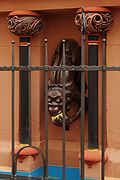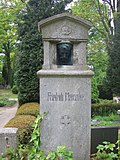Friedrich Meinecke (sculptor)
Friedrich Meinecke (born May 20, 1873 in Winsen an der Luhe ; † July 25, 1913 in Freiburg im Breisgau ) was a German sculptor who worked in Freiburg im Breisgau.
Life

Friedrich Meinecke, who wrote Meinicke himself , was the son of the Winsen pharmacist Theodor Meinecke. From October 1, 1894 to September 30, 1895, Friedrich Meinecke served as a one-year volunteer with the Royal Bavarian Infantry Body Regiment in Munich. In 1896 Friedrich Meinecke's brother Theodor had the Alte Rats-Apotheke built on Rathausstrasse in Winsen.
After living at Neuenburgerstrasse 24 in Berlin from 1898 to 1900, he went to Bonn in February 1900, presumably to get a place at university. In the same year he moved to Karlsruhe, where he was a student at the Grand Ducal Baden Academy of Fine Arts until 1905 .
In 1905 Friedrich Meinecke moved to Freiburg, where he last lived in Günterstalstrasse 8 after various addresses. He died unmarried in 1913 at the age of 40.
There is a memorial for Meinecke at the family grave site in Winsen an der Luhe, although he was not buried there.
plant
At the end of 1899, Meinecke completed a statue of Martin Luther , which is located on the church tower of St. Mary's Church in Winsen above the passage (north side).
One of the earliest works of Meinecke preserved in Freiburg is the Gutenberg group on the Freiburger Zeitung building at Martinstor from around 1905. At the same time he was involved in the facade design of what would later become the Gertrud Luckner trade school and the Affenbrunnen next to the Haus zum Walfisch in the Gauchstrasse. The shape was designed by the architect Paul Schuster , while Meinecke created the monkey, which offers plenty of room for interpretation. Due to its formerly green color, it was already mistaken for a frog.
His Bacchus Fountain, created in 1909 in Herdern , was already interpreted as Silenus with the lion . This boys' fountain with the cat was made in 1909 from sandstone and artificial stone.
His gnome , which was on the fountain of the turret at the Schwabentor Bridge, is now missing .
Martin Luther (Winsen an der Luhe)
Meinecke also made ethnographic mannequins, including a Wedda scene, which consisted of 13 plaster of paris people and was created under the guidance of and reference to the anthropological material of Fritz Sarasin from Basel. It was acquired by the Freiburg Museum of Natural History and Ethnology .
Individual evidence
- ↑ a b c Michael Klant: Forgotten sculptors. In: Sculpture in Freiburg. Volume 2: 19th Century Art in Public Space. Modo, Freiburg 2000, ISBN 3-922675-77-8 , pp. 164-172, especially p. 172.
- ↑ a b c d Appendix to letters on the Luther statue in Winsen 1897–1900 .
- ^ Theodor Meinecke: History of the pharmacy in Winsen ad Luhe (1668–1903) , Schulzesche Hof = Buchdruckerei A. Schwartz, Oldenburg 1903.
- ^ Information from Dr. Jürgen Klahn in an email, archived by the support team in the ticket: 2013080310004022
- ↑ Kurt Schoop: History of the Winsener church towers in: Winsener Geschichtsblätter , Heft 11, 1930, p. 41f.
- ↑ a b Rosemarie Beck, Roland Meinig: wells in Freiburg , Rombach, Freiburg im Breisgau, 1991, ISBN 3-7930-0550-X , p. 50
- ^ Rosemarie Beck, Roland Meinig: Brunnen in Freiburg , Rombach, Freiburg im Breisgau 1991, ISBN 3-7930-0550-X , p. 96.
- ^ Friedrich Meinecke (sculptor) (1878–1913) , universitaetssammlungen.de, accessed on August 18, 2013
Web links
| personal data | |
|---|---|
| SURNAME | Meinecke, Friedrich |
| ALTERNATIVE NAMES | Meinicke, Friedrich (own spelling) |
| BRIEF DESCRIPTION | German sculptor |
| DATE OF BIRTH | May 20, 1873 |
| PLACE OF BIRTH | Winsen an der Luhe |
| DATE OF DEATH | July 25, 1913 |
| Place of death | Freiburg in Breisgau |




